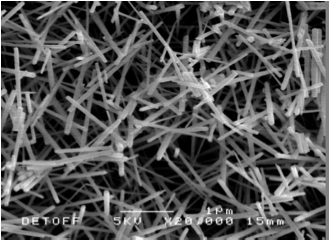Summer Studentship Update
24 October 2012

As reports from the Summer Studentships start to make their way back to us we’re getting very excited about the emerging collaborations that the scheme has stimulated throughout UCL.
For example, Chemistry student Ian Godfrey applied for an Institute of Making grant to work between the Chemistry and Chemical Engineering departments to explore how the vapour-deposition of catalysts might be able to improve the efficiency and reduce the negative environmental impacts of this process. Using a novel technique, the team deposited gold nanoparticles in a tungsten oxide medium onto a range of different materials like glass, alumina and silicon. They also captured this beautiful scanning electron microscope image showing the needle-like structure of their tungsten oxide thin films.
Starting from the principle that metal-based catalysts used in the chemical industries can be expensive and toxic to both humans and the environment, Ian Godrey applied for an Institute of Making Summer Studentship to explore how the vapour-depositing of catalysts might be able to improve the efficiency and reduce the negative environmental impacts of this process.
Godfrey worked in collaboration with Dr. C. Blackman in the UCL Chemistry Department and Prof. A. Gavriilidis from UCL Chemical Engineering. Drawing on Blackman’s expertise in chemical vapour deposition (CVD), a novel yet simple processing technique for producing functional nanomaterials, and Gavriilidis’ expertise in catalytic microreactors, they set out to investigate how they could reduce the amount of metals used in catalysis, employing a combination of nano-scale materials and microfluidics.
They used CVD to deposit gold nanoparticles onto a range of different materials like glass, alumina and silicon. In exploring the structure of the resulting material, they got some interesting and unpredicted results, especially with the glass, as the material’s structure was not as expected. This scanning electron microscope image shows the beautiful needle-like structure of the tungsten oxide thin films.
As a direct result of the studentship the team produced a range of samples with catalytic films that can now be tested for potential industrial application. The next stage of this project will be to test these materials for their ability to catalyse a carbon monoxide oxidation reaction. It is envisaged that future industrial processes could use microreactors in which the standard components are coated with catalytic films.
This project stimulated a new collaboration between Blackman and Gavriilidis, and gave Godfrey the opportunity to gain hands-on experience in an academic research lab and experience with a variety of experimental techniques that he would otherwise not have encountered. He says this experience has “fostered a greater appreciation for the links between a material’s underlying chemistry and its final properties and applications” and has encouraged him to “consider the different roles played by the diverse range of people in the materials development process e.g. engineers in reactor design, chemists in film development and optimization, chemical engineers in application and scale up”.